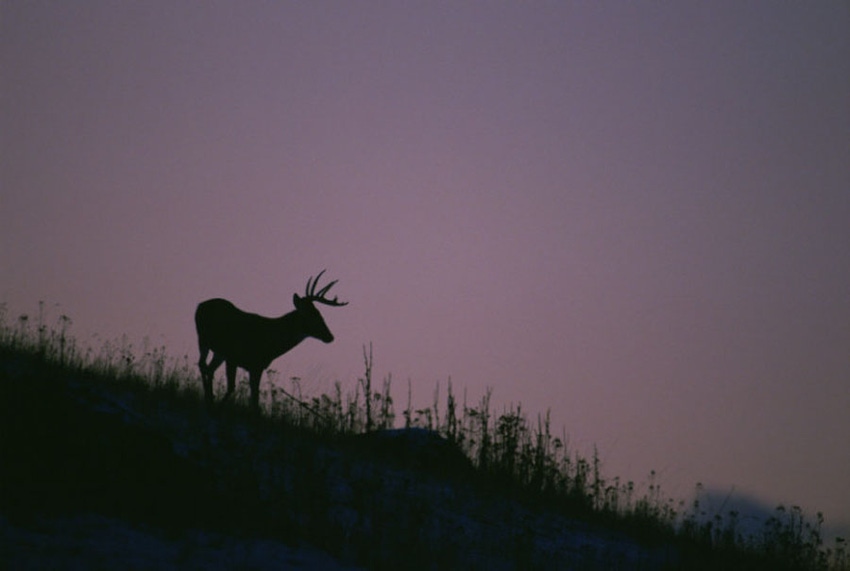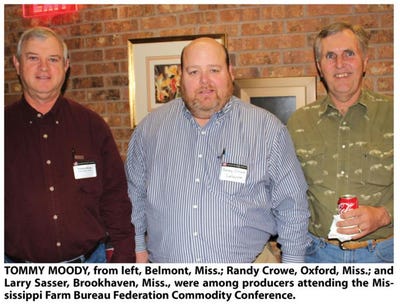
“Real estate agents in my central Mississippi territory tell me that recreational land is going for anywhere from $2,200 to $5,500 per acre," says William McKinley, deer program biologist with the Mississippi Department of Wildlife and Fisheries. "And before the downturn in the economy, they had some property that sold for as much as $6,500 to $7,000. A significant chunk of that is for deer hunting.”

Deer hunting accounts for three-fourths of the $1.1 billion in economic value that hunting generates annually in Mississippi, and hunting leases and fees can be an added source of revenue for farmland and timberland owners, says William McKinley, deer program biologist with the Mississippi Department of Wildlife and Fisheries.
Deer also are a valued source of food, not only for hunters but also a wide range of charities that benefit from donated deer meat, he said at the Mississippi Farm Bureau Federation Commodity Conference. And they support a broad array of corollary businesses, such as taxidermists and hunting suppliers.
But, McKinley notes, there is another side of the coin for the popular game animals: they’ve become so numerous that they’re causing millions of dollars annually in damage to agricultural crops, home landscaping and gardens, and to vehicles involved in collisions with deer.
“We’ve done population reconstruction analyses that show there are now at least two million deer in the state — and the figure could be even higher than that,” he says. “The result is that we’re seeing an upward trend in crop depredation, vehicle collisions, destruction of gardens, and other deer-related problems.”
That’s quite a contrast to 80 or so years ago when wildlife biologist Aldo Leopold, considered the father of conservation in the U.S., made a tour of Mississippi and estimated that there were only 1,200 deer left in the entire state.
“Our agency was formed in 1932 and by 1933 deer refuges were created across the state,” McKinley says. “As their numbers increased, they were moved into other areas of the state and released. All those releases involved only a dozen or so deer, but in the years since they’ve multiplied to the point that in many areas it’s not safe to drive down the highway at night.”
All this necessitates management programs and annual harvest to insure that the population doesn’t explode further, he says.
“If we don’t keep this deer population under control, we could face big-time problems. The only way to limit their numbers is to take out females. And while there are some who oppose this, imagine what would happen if we stopped harvesting 350,000 or so female deer each year.
“As bad as things are now, within one year those 350,000 could become 700,000, and in another year there could be another 1 million-plus deer out there.
“Good deer management can reduce these accident numbers and depredation of crops, gardens, etc.”
For the past three years, McKinley says, hunters have shot more does than bucks. “Mississippi hunters have been very cooperative in harvesting antlerless deer. One-third of the herd must be harvested or die each year to keep a level population, but even though the bag limit is eight, the average hunter takes only two deer each year.”
Because of a massive acorn crop this past fall and a very mild winter that has resulted in a lot of green native vegetation, the deer harvest has been below normal, he notes.
“There has been an ample amount of food, which has made the deer lazy, and lazy deer that don’t move around as much, and hunters don’t harvest as many. The observation rate of deer this winter has been the lowest in my 11 seasons with the agency. On the other hand, antler quality of deer harvested has been some of the best I’ve seen, and may be the best ever in the state.”
In 2009, when heavy rain and flooding resulted in large concentrations of deer in some areas, crop losses were extensive, McKinley says.
Damage to crops, gardens
“One farmer I know lost a 300-acre soybean field three times in a season — and that’s expensive. In some areas, deer numbers are getting to the point that homeowners are finding it almost impossible to have gardens. A lot of people depend on their gardens for a lot of their food, and deer can make a big dent in that food source.
“You may hear that dear won’t eat this, or won’t eat that, but the truth is, they’ll eat anything that’s fertilized. You put enough fertilizer on it and they’ll eat it. One of the few measures that has proven effective in protecting home gardens is a two-stage electric fence — one fence inside another.”
From October 2009 to January 3010, McKinley says, State Farm Insurance reported 14,738 deer/vehicle collisions, and “I’d guess that’s probably one-fourth the actual number, because a lot go unreported.”
Good deer management also is beneficial to other wildlife, he notes.
“A lot of birds and small mammals are threatened by not having enough cover because deer have eaten mid-story and under-story plants — weeds, forbs, little saplings are gone.
“Many sensitive native plants have been virtually eliminated by deer; strawberry bush, which once was common in the Mississippi hill, has been virtually eradicated; deer love it, it’s like ice cream to them. Mulberries are also vanishing; I seldom see a small mulberry tree. If we don’t keep deer under control, a lot of these valuable native plants are going to be lost.”
So, McKinley asks, if the deer population is basically skyrocketing, and hunters are harvesting over half a million each year, why should we be concerned about managing them?
“One very good reason,” McKinley says, “is money. Deer hunting generates a lot of money. It also is a source of food and supports a lot of jobs. Hunting is a strongly-rooted tradition in Mississippi.
“The beauty of hunting is that it’s both a rich man’s and a poor man’s sport. On one end of the spectrum, there are hunting clubs with high dollar buy-ins and on the other end, there are individual hunters who go out with just a box of ammo and a hunting license. Deer camps range from primitive to luxurious. There are over 1 million acres of public land for hunting in the state, with either free access or only a $15 fee for access to more than 500,000 acres of wildlife management areas.
“Hunters buy a tremendous amount of stuff, from guns and ammo to camouflage to deer stands to food for camping.
“Real estate agents in my central Mississippi territory tell me that recreational land is going for anywhere from $2,200 to $5,500 per acre and before the downturn in the economy, they had some property that sold for as much as $6,500 to $7,000. A significant chunk of that is for deer hunting.
“There are people from other states wanting to buy this land; I know of one deal for 500 acres that sold for $10,000 per acre, simply due to the high quality of the deer on the property.”
Hunting leases can also be a good source of revenue, McKinley says. “I don’t know of any leases for less than $10 an acre, and $50 or more is not that uncommon.”
Important food source
Deer represents a significant food source, he says. “Deer meat has replaced the backyard pigpen or two or three-acre cattle pasture for many Mississippians. An average size doe deer will yield about 30 pounds of red meat; with more than 350,000 harvested each year, that’s over 10 million pounds of venison — a significant amount of food being provided to hunters courtesy of Mother Nature.
“This also supports jobs such as meat processors; in fact, processing of venison now equals or exceeds that of beef or pork for many processors. One facility I know processes 14,000 deer per year.”
Venison is an important source of donated food to charitable institutions, soup kitchens, etc., McKinley says. “They get tons of meat each year from hunters. Through a grant to Mississippi Wildlife Federation, hunters can leave deer at drop-off points for processing and distribution to the state’s needy. Non-hunting families also benefit from gifts of deer meat from hunter friends. All this helps create a positive image of hunting.”
Deer constitute a large portion of the business for taxidermists, he notes, with an average mount running $400 or so. “I know one taxidermist who does 500 or more deer mounts a year.”
And beyond all that, McKinley says, “You can’t assign a dollar value to tradition — to time spent in the outdoors with children, grandchildren, or other family members and friends, the fellowship that is part of hunting, fishing, and other forms of outdoors recreation.”
There are a number of steps involved in managing deer, he says:
· Keep the deer herd in balance with the habitat. This includes harvest of antlerless deer. “There are some who think you shouldn’t shoot a doe,” McKinley says. “That was the case in the 1950s, 60s, and 70s, but it’s not true today, when we’re dealing with rapidly growing deer herds that are exceeding carrying capacity. The only way to minimize reproduction and control the numbers is to take out females.”
· A balanced age structure for bucks. “A healthy herd has bucks of varying ages to limit breeding stress on younger bucks. You end up with better breeding and a healthier herd that’s easier to control.”
· Manage your habitat, such as timberland. “This involves controlled burning and other management techniques to promote vegetation that will provide cover and food for turkey, rabbits, and other wildlife,” McKinley says.
· Food plots are important, but he says “the key is to provide something that will be long term – not just a half-acre of ryegrass, wheat or oats. Food plots are important to draw in deer to facilitate harvest and take out the numbers needed to manage populations.”
· Enclosures can be effective management tool, if used correctly, McKinley says. “They’re most effective if they’re used to keep deer out. But this requires intensive management. Some of the best-managed wildlife habitat I’ve seen has been inside enclosures; conversely, some of the worst-managed habitat I’ve seen has been inside enclosures. When you put up a fence, it changes the game.”
· Keep data on the deer herd. “If you’re managing your deer, you should be managing data on that herd,” McKinley says. “We offer a free program for properties of 1,000 acres or more. In the DMAP —Deer Management Assistance Program — we take the data collected by landowners and generate a site-specific report that tells how many deer you should be harvesting. We currently have about 2.1 million acres enrolled in this program in Mississippi.”
The Department of Wildlife and Fisheries offers technical guidance to private landowners and leaseholders, McKinley notes. “We go to their property, walk around with them, show them things they may never have seen, and give them an idea of how many deer they have on their land.”
He suggests: “Get professional help if you’re truly interested in managing your deer herd. We have a staff of wildlife biologists who can assist with deer and other wildlife management.”
And McKinley says, however damaging deer may be in many areas of Mississippi, “Wild pigs are now Public Enemy No. 1; they are doing tremendous amounts of damage to crops and property, as well as to habitat for other wildlife. We encourage hunters to take them by any means necessary. You will help protect and conserve other wildlife by doing so.”
About the Author(s)
You May Also Like



